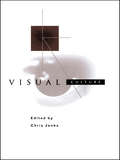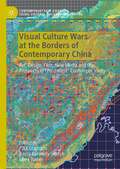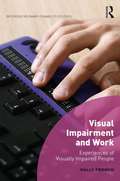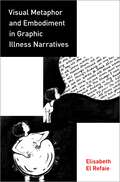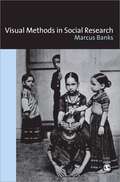- Table View
- List View
A Visual Approach to the Study of Religious Orders: Zooming in on Monasteries (Routledge Studies in the Sociology of Religion)
by Marcin Jewdokimow Thomas Quartier OsbA Visual Approach to the Study of Religious Orders applies visual methods to the exploration of various facets of religious life, such as everyday lived experience, contemporary monastic identity or monastic architecture. Presenting a series of visual essays, it treats images not as simple illustrations but as an autonomous form of expression, capable of unveiling vital and developmental layers of experience, while inviting readers to examine and interpret the data themselves. The first book of its kind, it brings together case studies from various locations across Europe to demonstrate what the use of visual methodologies can contribute to social scientific research on religious orders. As such, it will appeal to scholars and students of sociology, religious studies and theology and anyone with interests in religious orders.
Visual Art and Education in an Era of Designer Capitalism: Deconstructing the Oral Eye (Education, Psychoanalysis, and Social Transformation)
by jan jagodzinskiThis book offers a unique perspective of art and its education in designer capitalism. It will contribute to the debate as to possibilities art and design hold for the future. It also questions the broad technologization of art that is taking place.
Visual Communication for Social Work Practice: Power, Culture, Analysis (Routledge Advances in Social Work)
by Sonia M. TascónHow are we to understand how the dominance of visual images and representations in late modernity affects Social Work practice, research and education? Social workers are increasingly using still and moving images to illustrate their work, to create new knowledge, and to further specific groups’ interests. As a profession in which communication is central, visual practices are becoming ever more significant as they seek to carry out their work with, and for, the marginalised and disenfranchised. It is time for the profession to gain more critical, analytical, and practical knowledge of visual culture and communication, in order to use and create images in accordance with its central principle of social justice. That requires an understanding of them beyond representation. As important as this is, it is also where the profession’s scholarly work in this area has remained and halted, and thus understanding of the work of images in our practices is limited. In order to more fully understand images and their effects – both ideologically and experientially – social workers need to bring to bear other areas of study such as reception studies, visual phenomenology, and the gaze. These other analytical frames enable a consideration not only of images per se, but also of their effect on the viewer, the human spectators, and the subjects at the heart of Social Work. By bringing understandings and experiences in Film, Media, and Communications, Visual Communication for Social Work Practice provides the reader with a wide range of critically analytical frames for practitioners, activists, educators, and researchers as they use and create images. This invites a deeper knowledge and familiarity with the power dimensions of the image, thus aligning with the social justice dimension of Social Work. Examples are provided from cinema, popular media, but more importantly from Social Work practitioners themselves to demonstrate what has already been made possible as they create and use images to further the interpersonal, communal, and justice dimensions of their work. This book will be of interest to scholars, students, and social workers, particularly those with an interest in critical and creative methodologies.
Visual Communication for Social Work Practice: Power, Culture, Analysis (Routledge Advances in Social Work)
by Sonia M. TascónHow are we to understand how the dominance of visual images and representations in late modernity affects Social Work practice, research and education? Social workers are increasingly using still and moving images to illustrate their work, to create new knowledge, and to further specific groups’ interests. As a profession in which communication is central, visual practices are becoming ever more significant as they seek to carry out their work with, and for, the marginalised and disenfranchised. It is time for the profession to gain more critical, analytical, and practical knowledge of visual culture and communication, in order to use and create images in accordance with its central principle of social justice. That requires an understanding of them beyond representation. As important as this is, it is also where the profession’s scholarly work in this area has remained and halted, and thus understanding of the work of images in our practices is limited. In order to more fully understand images and their effects – both ideologically and experientially – social workers need to bring to bear other areas of study such as reception studies, visual phenomenology, and the gaze. These other analytical frames enable a consideration not only of images per se, but also of their effect on the viewer, the human spectators, and the subjects at the heart of Social Work. By bringing understandings and experiences in Film, Media, and Communications, Visual Communication for Social Work Practice provides the reader with a wide range of critically analytical frames for practitioners, activists, educators, and researchers as they use and create images. This invites a deeper knowledge and familiarity with the power dimensions of the image, thus aligning with the social justice dimension of Social Work. Examples are provided from cinema, popular media, but more importantly from Social Work practitioners themselves to demonstrate what has already been made possible as they create and use images to further the interpersonal, communal, and justice dimensions of their work. This book will be of interest to scholars, students, and social workers, particularly those with an interest in critical and creative methodologies.
Visual Communication Theory and Research: A Mass Communication Perspective
by S. Fahmy M. Bock W. WantaIn today's multimedia environment, visuals are essential and expected parts of storytelling. However, the visual communication research field is fragmented into several sub-areas, making study difficult. Fahmy, Bock, and Wanta note trends and discuss the challenges of conducting analysis of images across print, broadcast, and online media.
Visual Culture
by Chris JenksIn Visual Culture the 'visual' character of contemporary culture is explored in original and lively essays. The contributors look at advertising, film, painting and fine art, journalism, photography, television and propaganda. They argue that there is only a social, not a formal relation between vision and truth.
Visual Culture
by Chris JenksIn Visual Culture the 'visual' character of contemporary culture is explored in original and lively essays. The contributors look at advertising, film, painting and fine art, journalism, photography, television and propaganda. They argue that there is only a social, not a formal relation between vision and truth.
Visual Culture
by Chris JenksIn Visual Culture the 'visual' character of contemporary culture is explored in original and lively essays. The contributors look at advertising, film, painting and fine art journalism, photography, television and propaganda. They argue that there is only a social, not a formal relation between vision and truth. A major preoccupation of modernity and central to an understadning of the postmodern, 'vision' and the 'visual' are emergent themes across sociology, cultural studies and critical theory in the visual arts. Visual Culture will prove an indispensable guide to the field.
Visual Culture
by Chris JenksIn Visual Culture the 'visual' character of contemporary culture is explored in original and lively essays. The contributors look at advertising, film, painting and fine art journalism, photography, television and propaganda. They argue that there is only a social, not a formal relation between vision and truth. A major preoccupation of modernity and central to an understadning of the postmodern, 'vision' and the 'visual' are emergent themes across sociology, cultural studies and critical theory in the visual arts. Visual Culture will prove an indispensable guide to the field.
Visual Culture Wars at the Borders of Contemporary China: Art, Design, Film, New Media and the Prospects of “Post-West” Contemporaneity (Contemporary East Asian Visual Cultures, Societies and Politics)
by Paul Gladston Beccy Kennedy-Schtyk Ming TurnerThis edited collection brings together essays that share in a critical attention to visual culture as a means of representing, contributing to and/or intervening with discursive struggles and territorial conflicts currently taking place at and across the outward-facing and internal borders of the People’s Republic of China. Elucidated by the essays collected here for the first time is a constellation of what might be described as visual culture wars comprising resistances on numerous fronts not only to the growing power and expansiveness of the Chinese state but also the residues of a once pervasively suppressive Western colonialism/imperialism. The present volume addresses visual culture related to struggles and conflicts at the borders of Hong Kong, the South China Sea and Taiwan as well within the PRC with regard the so-called “Great Firewall of China” and differences in discursive outlook between China and the West on the significances of art, technology, gender and sexuality. In doing so, it provides a vital index of twenty-first century China’s diversely conflicted status as a contemporary nation-state and arguably nascent empire.
Visual History und Geschichtsdidaktik: Bildkompetenz in der historisch-politischen Bildung (Reihe Geschichtswissenschaft #53)
by Christoph Hamann„der fotografie-unkundige wird der analfabet der zukunft sein.“ (Lázló Moholy-Nagy, 1928). Geschichte ist mehr denn je visualisierte Geschichte: das Lagertor von Auschwitz-Birkenau (1945), der Atompilz von Hiroshima (1945), der landende „Rosinenbomber“ in Berlin (1948), die Steinewerfer vom Potsdamer Platz (1953) die gescheiterte Flucht Peter Fechters (1962), das Napalm Girl (1972), die Anschläge vom 11. September 2001 – diese Fotografien haben sich tief im kollektiven Gedächtnis eingegraben. Der Historiker und Geschichtsdidaktiker Christoph Hamann untersucht die Fotografie als ein zentrales Medium der historischen Erinnerung. Er analysiert exemplarisch kanonisierte Schlüsselbilder und zeigt, wie mit diesen historische Deutungen transportiert werden. Diese fotografische visual history wird im Kontext der Geschichte der deutschen wie globalen Erinnerungskultur betrachtet. Ein besonderes Augenmerk wird auf die Ästhetik der Bilder geworfen. Denn die mediale Formatierung der kollektiven Geschichtswahrnehmung wird durch diese beeinflusst. Christoph Hamann räumt der Form des fotografischen Bildes eine semantische Funktion ein und verortet die Bilder in ikonografischen Traditionen. Der Einfluss von Visualisierungen auf das individuelle wie kollektive Geschichtsbewusstsein ist empirisch belegt – diese Erkenntnis ist für das historische Lernen von elementarer Bedeutung. Hamanns Ausführungen reflektieren deswegen die Notwendigkeit sowie die Möglichkeiten der Förderung einer kritischen Bildkompetenz in der historisch-politischen Bildung. Die historischen Wissenschaften müssen ihre ästhetische Unmündigkeit überwinden – im historiographischen, geschichtsdidaktischen wie unterrichtspragmatischen Interesse. Denn Moholy-Nagys Zukunft ist längst Gegenwart.
Visual Impairment and Work: Experiences of Visually Impaired People (PDF)
by Sally FrenchThis book traces the development of paid work for visually impaired people in the UK from the 18th century to the present day. It gives a voice to visually impaired people to talk about their working lives and documents the history of employment from their experience, an approach which is severely lacking in the current literature about visual impairment and employment. By analysing fifty in-depth face-to-face interviews with visually impaired people talking about their working lives (featuring those who have worked in traditional jobs such as telephony, physiotherapy and piano tuning, to those who have pursued more unusual occupations and professions), and grouping them according to occupation and framed by documentary, historical research, these stories can be situated in their broader political, economic, ideological and cultural contexts. The themes that emerge will help to inform present day policy and practice within a context of high unemployment amongst visually impaired people of working age. It is part of a growing literature which gives voice to disabled people about their own lives and which adds to the growing academic discipline of disability studies and the empowerment of disabled people.
Visual Impairment and Work: Experiences of Visually Impaired People
by Sally FrenchThis book traces the development of paid work for visually impaired people in the UK from the 18th century to the present day. It gives a voice to visually impaired people to talk about their working lives and documents the history of employment from their experience, an approach which is severely lacking in the current literature about visual impairment and employment. By analysing fifty in-depth face-to-face interviews with visually impaired people talking about their working lives (featuring those who have worked in traditional jobs such as telephony, physiotherapy and piano tuning, to those who have pursued more unusual occupations and professions), and grouping them according to occupation and framed by documentary, historical research, these stories can be situated in their broader political, economic, ideological and cultural contexts. The themes that emerge will help to inform present day policy and practice within a context of high unemployment amongst visually impaired people of working age. It is part of a growing literature which gives voice to disabled people about their own lives and which adds to the growing academic discipline of disability studies and the empowerment of disabled people.
The Visual in Social Theory
by Anthony WoodiwissThe distinction between understanding sight as a natural faculty - vision - and understanding it as an historical and social construct - visuality - has had significant impact in the visual arts. Not so in social theory where, notwithstanding the efforts of the classical theorists, the practical scientific necessity of privileging visuality over vision has been lost. The Visual in Social Theory argues that, because of its uncritical use of terms like modernity, postmodernity, globalisation and the Third Way, contemporary social theory has become a participant in rather than a critic of 'promotional culture'. In short, in forgetting its past social theory has effectively forsaken its future. The Visual in Social Theory aims to restore the self-discipline and critical edge intrinsic to any analytical work on visuality. The book will be essential reading not only for those interested in contemporary debates around vision but for a broader readership concerned for the critical relevance of contemporary social theory.
Visual Marketing: From Attention to Action (Marketing And Consumer Psychology Ser.)
by Michel Wedel Rik PietersThis comprehensive volume aims to further research and theory development in visual marketing. By bringing together leading researchers in the field, it strives to contribute to the establishment of visual marketing as a coherent discipline. The chapters represent an array of issues in visual marketing. They address three areas in theory: attention
Visual Marketing: From Attention to Action
by Michel Wedel Rik PietersThis comprehensive volume aims to further research and theory development in visual marketing. By bringing together leading researchers in the field, it strives to contribute to the establishment of visual marketing as a coherent discipline. The chapters represent an array of issues in visual marketing. They address three areas in theory: attention
Visual Mathematics and Cyberlearning (Mathematics Education in the Digital Era)
by Dragana Martinovic, Viktor Freiman and Zekeriya KaradagThis first book in the series will describe the Net Generation as visual learners who thrive when surrounded with new technologies and whose needs can be met with the technological innovations. These new learners seek novel ways of studying, such as collaborating with peers, multitasking, as well as use of multimedia, the Internet, and other Information and Communication Technologies. Here we present mathematics as a contemporary subject that is engaging, exciting and enlightening in new ways. For example, in the distributed environment of cyber space, mathematics learners play games, watch presentations on YouTube, create Java applets of mathematics simulations and exchange thoughts over the Instant Messaging tool. How should mathematics education resonate with these learners and technological novelties that excite them?
Visual Metaphor and Embodiment in Graphic Illness Narratives
by Elisabeth El RefaieMetaphors help us understand abstract concepts, emotions, and social relations through the concrete experience of our own bodies. Conceptual Metaphor Theory (CMT), which dominates the field of contemporary metaphor studies, is centered on this claim. According to this theory, correlations in the way the world is perceived in early childhood (e.g., happy/good is up, understanding is seeing) persist in our conceptual system, influencing our thoughts throughout life at a mostly unconscious level. What happens, though, when ordinary embodied experience is disrupted by illness? In this book, Elisabeth El Refaie explores how metaphors change according to our body's alteration due to disease. She analyzes visual metaphor in thirty-five graphic illness narratives (book-length stories about disease in the comics medium), re-examining embodiment in traditional CMT and proposing the notion of "dynamic embodiment." Building on recent strands of research within CMT and engaging relevant concepts from phenomenology, psychology, semiotics, and media studies, El Refaie demonstrates how the experience of our own bodies is constantly adjusting to changes in our individual states of health, socio-cultural practices, and the modes and media by which we communicate. This fundamentally interdisciplinary work also proposes a novel classification system of visual metaphor, based on a three-way distinction between pictorial, spatial, and stylistic metaphors. This approach will enable readers to advance knowledge and understanding of phenomena involved in shaping our everyday thoughts, interactions, and behavior.
Visual Metaphor and Embodiment in Graphic Illness Narratives
by Elisabeth El RefaieMetaphors help us understand abstract concepts, emotions, and social relations through the concrete experience of our own bodies. Conceptual Metaphor Theory (CMT), which dominates the field of contemporary metaphor studies, is centered on this claim. According to this theory, correlations in the way the world is perceived in early childhood (e.g., happy/good is up, understanding is seeing) persist in our conceptual system, influencing our thoughts throughout life at a mostly unconscious level. What happens, though, when ordinary embodied experience is disrupted by illness? In this book, Elisabeth El Refaie explores how metaphors change according to our body's alteration due to disease. She analyzes visual metaphor in thirty-five graphic illness narratives (book-length stories about disease in the comics medium), re-examining embodiment in traditional CMT and proposing the notion of "dynamic embodiment." Building on recent strands of research within CMT and engaging relevant concepts from phenomenology, psychology, semiotics, and media studies, El Refaie demonstrates how the experience of our own bodies is constantly adjusting to changes in our individual states of health, socio-cultural practices, and the modes and media by which we communicate. This fundamentally interdisciplinary work also proposes a novel classification system of visual metaphor, based on a three-way distinction between pictorial, spatial, and stylistic metaphors. This approach will enable readers to advance knowledge and understanding of phenomena involved in shaping our everyday thoughts, interactions, and behavior.
Visual Methodologies and Digital Tools for Researching with Young Children: Transforming Visuality (International Perspectives on Early Childhood Education and Development #10)
by Marilyn Fleer Avis RidgwayThis book makes an original contribution to researching child-community development so that those with specific interests in early childhood education have new theoretical tools to guide their research practices. The book explicitly theorises the use of digital visual tools from a cultural-historical perspective. It also draws upon a range of post-structuralist concepts for moving research and scholarship forward. Examples of visual technologies from research in different cultural communities are foregrounded. In particular this book introduces contemporary methodologies for researching child and community development with a focus on visual methodology so the dynamics of development can be captured over time and analysed historically, culturally, socially, ecologically and psychologically through a range of iterative techniques. Visual technology was not freely available in Vygotsky’s time for example, and therefore potentially represents an extension of his genetic experimental approach to researching child development. The book presents a range of methodological arguments about research into child and community development through which new conceptions for research centred on young children have been created. The authors of the chapters also discuss why a more holistic, dynamic and ethical view of research is needed for generating new knowledge about child development in a range of cultural contexts.
Visual Methods in Marketing and Consumer Research (Routledge Studies in Marketing)
by Fatema KawafDespite the rising popularity of visual research methods, from images and collages to videos and animations, there is an imminent need for a book that can be a point of reference for learning about visual methods in the field of marketing and consumer research. This book offers a comprehensive outlook of visual research methods in the field, highlighting their value and offering a practical guide for researchers. Building on the experiences and discussions of both experienced and aspiring visual researchers, the editors present this book as a ‘go‑to’ guide for doing visual research in marketing and consumer research.This book encompasses nine chapters guiding the readers through the ABCs of visual research from philosophy to data collection and analysis, with a dedicated chapter on research dissemination. You can expect detailed discussions on the ontological and epistemological stance of visual research as well as an elaborate yet simple to follow guide of all aspects of data collection for various forms of visuals, be it static images, memes, collages, videos, animations and so on.The purpose of this book is not only to highlight the value of visual methods in consumer research but also to move this work on and offer a ‘go-to hands-on guide’ for novice visual researchers and PhD candidates who wish to conduct rigorous visual research. It will be a valuable resource not only for those particularly across marketing disciplines, including consumer research and behaviour, but also for visual researchers in fields such as sociology and anthropology.
Visual Methods in Marketing and Consumer Research (Routledge Studies in Marketing)
Despite the rising popularity of visual research methods, from images and collages to videos and animations, there is an imminent need for a book that can be a point of reference for learning about visual methods in the field of marketing and consumer research. This book offers a comprehensive outlook of visual research methods in the field, highlighting their value and offering a practical guide for researchers. Building on the experiences and discussions of both experienced and aspiring visual researchers, the editors present this book as a ‘go‑to’ guide for doing visual research in marketing and consumer research.This book encompasses nine chapters guiding the readers through the ABCs of visual research from philosophy to data collection and analysis, with a dedicated chapter on research dissemination. You can expect detailed discussions on the ontological and epistemological stance of visual research as well as an elaborate yet simple to follow guide of all aspects of data collection for various forms of visuals, be it static images, memes, collages, videos, animations and so on.The purpose of this book is not only to highlight the value of visual methods in consumer research but also to move this work on and offer a ‘go-to hands-on guide’ for novice visual researchers and PhD candidates who wish to conduct rigorous visual research. It will be a valuable resource not only for those particularly across marketing disciplines, including consumer research and behaviour, but also for visual researchers in fields such as sociology and anthropology.
Visual Methods In Social Research (PDF)
by Marcus BanksThere has been an explosion of interest in visual culture</p
Visual Methods in the Field: Photography for the Social Sciences
by Terence HengThe use of images, particularly photography, has been steadily gaining popularity in academia, but there has not yet been a book that deals with the act and process of photo-taking in the field. Drawing upon 21 years of photographic experience and sociological research, Terence Heng’s immersive and narrative style will: introduce photography as a qualitative method; discuss the intricacies of, challenges in and opportunities for using a camera in the field; explore common themes and topics in social science research, including photographing rituals, space, people and objects; advise on navigating the always evolving technological landscapes of traditional, digital and mobile photography. Visual Methods in the Field: Photography for the Social Sciences is a photography guide written for researchers by a researcher. Using in-depth ethnographic case studies from research done in various urban environments, this book will act as a crucial bridge for students in geography, sociology, education, media studies and other social sciences to incorporate photography into their research repertoire.
Visual Methods in the Field: Photography for the Social Sciences
by Terence HengThe use of images, particularly photography, has been steadily gaining popularity in academia, but there has not yet been a book that deals with the act and process of photo-taking in the field. Drawing upon 21 years of photographic experience and sociological research, Terence Heng’s immersive and narrative style will: introduce photography as a qualitative method; discuss the intricacies of, challenges in and opportunities for using a camera in the field; explore common themes and topics in social science research, including photographing rituals, space, people and objects; advise on navigating the always evolving technological landscapes of traditional, digital and mobile photography. Visual Methods in the Field: Photography for the Social Sciences is a photography guide written for researchers by a researcher. Using in-depth ethnographic case studies from research done in various urban environments, this book will act as a crucial bridge for students in geography, sociology, education, media studies and other social sciences to incorporate photography into their research repertoire.




